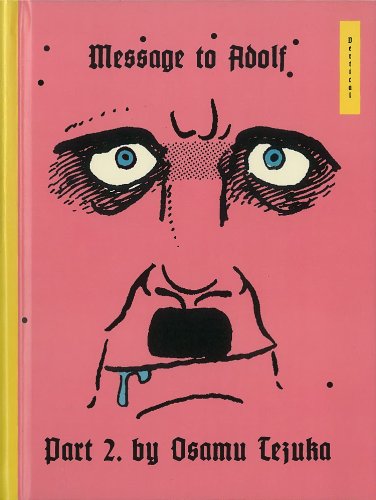15 Feb / Message to Adolf (Part 2) by Osamu Tezuka, translated by Kumar Sivasubramanian

 Official word of warning: this is NOT your kiddies’ manga. Both in subject matter and graphics, Message is definitely for mature audiences. So if you have younger ones in the house, be careful not to leave the book lying around. The “godfather of manga” has plenty of other titles for the young ‘uns … his iconic Astro Boy, in spite of darker undertones parents might recognize, is a great place for the kiddies to get to know manga-godpapa.
Official word of warning: this is NOT your kiddies’ manga. Both in subject matter and graphics, Message is definitely for mature audiences. So if you have younger ones in the house, be careful not to leave the book lying around. The “godfather of manga” has plenty of other titles for the young ‘uns … his iconic Astro Boy, in spite of darker undertones parents might recognize, is a great place for the kiddies to get to know manga-godpapa.
But back to Adolf: not to keep telling you what to do – but I definitely need to here … make sure you read Part 1 of this two-volume epic work before venturing forth. To start in the middle is not recommended: if nothing else, check out the orange cover for Part 1, then compare it to this pink cover here: der Führer is degenerating before your eyes, and you’re going to need to know why before you open Part 2.
Der Führer – who we clearly know to be evil incarnate – is only one of the three Adolfs in the midst of losing his humanity. Part 2 begins with Adolf Kaufmann still able to agonize over his murderous spree: “In a few years, I’ll probably be like the SS or Gestapo, able to kill Jews without batting an eye … no, with a smirk on my face!” he writes in a letter marred by tears and sweat that he will never be able to send to his Japanese mother. Holding on to what conscience he has left – and smitten for the first time in his life – he risks his own safety to send a young Jewish girl, Elisa, to Kobe, Japan, in the care of his childhood (Jewish) best friend, Adolf Kamil.
Kaufmann is handpicked by the Führer himself to be his “Apprentice Secretary.” He rises rapidly through the ranks of the SD [the Nazi intelligence agency, Sicherheitsdienst des Reichsführers]; his blind loyalty gives him chilling, murderous efficiency. Meanwhile, in Japan, Kamil and his mother welcome Elisa, who becomes an integral part of their shrunken family. In spite of grave danger, Kamil and Ms. Ogi keep working to disperse the secret documents that could possibly destroy Hitler, out to the rest of the world.
Even after Hitler falls (you won’t find the the version the school books taught you here), Kaufmann and Kamil’s battles continue, moving through Europe, Japan, and finally to the Middle East. Even the end of a world war can’t sever their gruesome bond. Lies, betrayal, vengeance, rape, suicide, murder, all drive up the body count – and through it all, the indestructible Sohei Toge continues to record the tragedy: “This is the story of three men named Adolf,” the epics ends – just as it began, “They each followed a different course in their lives, but they were bound together by one thread of destiny. Now that the last Adolf lies dead, I present this tale to our descendants.”
And so the story starts again, rising from the ashes of a faraway graveyard. Dare we hope that somehow, history will not repeat itself again … and again and again …?
Readers: Adult
Published: 2012 (United States)
